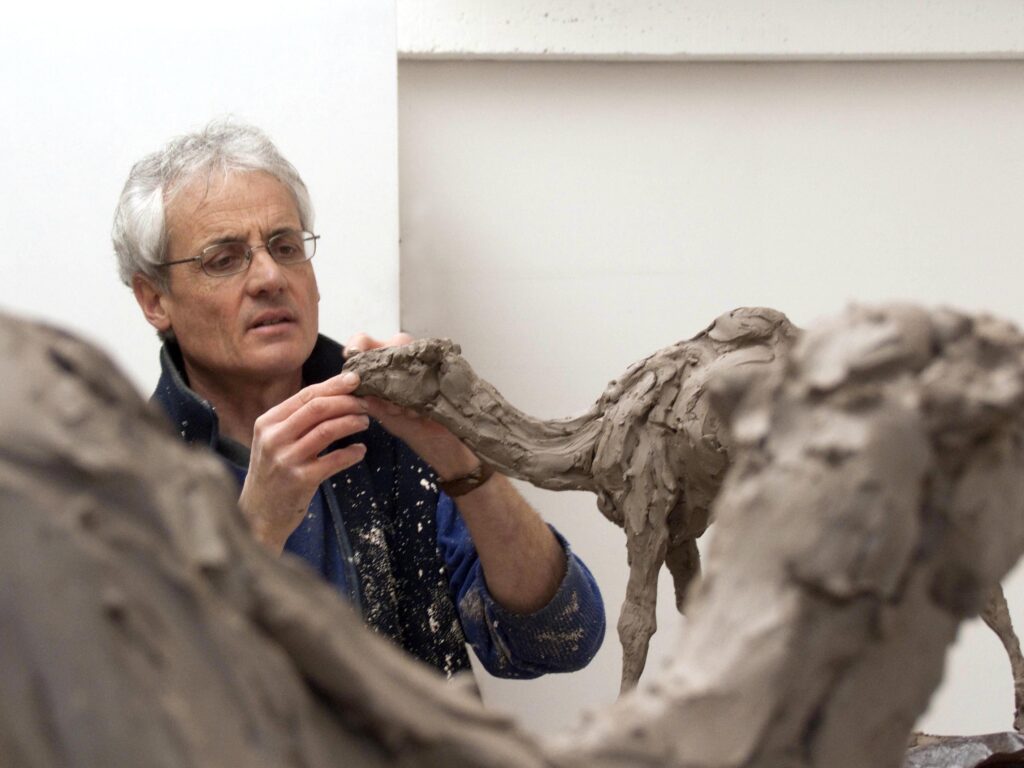
The sculpture “On Their Way” was created by French artist Roch Vandromme and installed in 2013, outside the National Museum of Qatar in Doha. This is the magnificent sculpture of four dromedaries (one-hump Arabian camels): two mature standing at the back and two calves at the front. The material used for sculpting the camels is bronze. Bronze could be motley, from being originally gold or light brown and changing to a completely different color, as a result of patina on the surface achieved through oxidation. That’s why the “On their way” sculpture gives off a blue-green coating when it’s under shade and dark brown when it’s under open sunlight. The installation depicts the dynamic and close relationship between humans and camels.
Vandromme is known for his “snapshotting of animals at peace in their natural state and giving them life in bronze sculptures”. The close bond between camels and desert people inspired Vandromme to visit Qatar in 2009, witness the relationship, and obtain inspiration to produce the sculpture later in 2013. Indeed, camels played an integral role in Qatar’s long history and its nomadic lifestyle in the past. Roch’s sculpture embodies the appreciation and embracement of the progressive and dynamic relationship between humans and camels. Two mature calves at the back represent the shared human-camel history and two calves at the front celebrate the continuation of the relationship in present and in the future. In this blog post, I argue that assigning the importance of symbols that emerged from humans and translating them to camels would be wrong. For that, I am going to rely on Eduardo Kohn’s How Forests Think and such concepts as anthropocentric narcissism and logic of forms.
Kohn in his book talks about the community of people, the Runa, and their coexistence with the forest. The sculpture represents the camels and the life they shared with desert nomads in Qatar. The common ground of both human and non-human lives existing in the same ecological niche makes the comparison relevant to a certain extent. Kohn argued that anthropocentric narcissism is embedded in our desires to attach morality shaped by human politics to morality in the nonhuman world. He states, “in the hopeful politics we seek to cultivate, we privilege heterarchy over hierarchy, the rhizomatic…we celebrate the fact such horizontal processes…can be found in the nonhuman living world”. He disagrees with this implication of morality and emphasizes that human morality can’t be translated to animals, especially while judging the equality between human and non-human living forms. In this sense, the sculpture “On their way” needs careful expertise: expecting camels to appreciate the human-camel friendship the same way humans tend to do it might be inaccurate as camels could view this political association in a completely different manner.
Another obstacle in making the translation of the human-camel relationship valuable both for humans and camels is the differences in the minds and forms of thinking. Kohn argued that the logic of form determines the logic of living thoughts and wondered what would happen to thought if it was free from intention. Of course, it is difficult to get inside the form, get inside the camel’s mind and see the sculpture from its point of view and track the camel’s thoughts and the sense it makes out of perceiving the sculpture. So, it means that a lack of understanding and evidence of how different living forms form associations in their minds leads to the conclusion that the sculpture, for now, is made for us and for our own appreciation.
Kohn, Eduardo. How forests think: Toward an anthropology beyond the human. Univ of California Press, 2013.
Vandromme, Roch. “On their way (2013) at National Museum of Qatar (NMoQ) Architect Jean Nouvel”. Roch Vandromme. October 12, 2022, https://roch-vandromme.com/musee-national-du-qatar/?lang=en.
Video showing “On their way” sculpture published by Qatar Museums: https://youtu.be/FYy0YsitrKQ